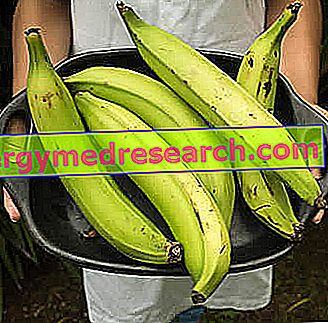What is plane tree?
Definition and disambiguation
Platano ( plantain ) is the common name of the fruits (bananas) produced by a giant herbaceous plant, belonging to the Musaceae family and to the genus Musa . It is a hybrid between the wild species M. acuminata and M. balbisiana, identified by the binomial nomenclature Musa × paradisiaca .

The plane trees are an important source of nourishment for the populations that cultivate them, since they are rich in carbohydrates and fructify abundantly throughout the year.
Often, the name platano is used to indicate all the varieties belonging to the genus Musa used for cooking, which is why "platano" has become almost synonymous with " cooking banana ".
The platano banana proper is of an intense green color when the fruit is unripe, or at the moment when it should be cooked, and becomes softer with maturation; since it is eaten cooked but mainly unripe, it is also nicknamed "green banana".
There is no rigid botanical distinction between "normal" bananas (the best known in Italy) and plantain bananas; instead they are slightly different hybrids and cultivars.
All modern plant cultivars have three sets of chromosomes (ie triploids).
Platano: how to eat?
Plane banana cooking is often a matter of taste rather than a necessity. When fully ripe, the plane tree can also be eaten raw, since the starches that characterize it are converted into sugars (as in common bananas). The same applies to the common yellow bananas which, when immature, can be cooked easily.
In practice, the difference between cooking bananas and those that are eaten most frequently is simply a predisposition to one or the other consumption. This explains why in many countries bananas that are eaten raw compared to plane trees cannot be distinguished, being marketed under a single nomenclature.
How to Peel the Plane Tree - Properties and Curiosities
X Problems with video playback? Reload from YouTube Go to Video Page Go to Video Recipes Section Watch the video on youtubeMountain plane tree
The bananas of Fe'i of the Pacific islands ( Musa × troglodytarum - a hybrid totally different from the plane tree), are cooking bananas that are eaten roasted or boiled, and are informally called "mountain plane trees".
Property
Nutritional characteristics of the plane tree
The plane tree banana contains 32% of carbohydrates, with 2% of dietary fiber and 15% of sugars, 1% of proteins, 0.4% of fats and 65% of water. Provides 122 kcal / 100 g.
Energy is therefore supplied mainly by glucides (almost equally divided between simple and complex), followed marginally by low biological value proteins and lipids.
The plane tree does not contain cholesterol and the fibers are abundant.
Raw is an excellent source of vitamin B6, vitamin C, magnesium and potassium. It contains few carotenoids (beta-carotene); it is therefore not a good source of vitamin A.
The plane tree (raw, roasted or boiled) lends itself to most diets; the portion should be adjusted in case of overweight and type 2 diabetes mellitus. It may, in different quantities, replace the tubers (eg potatoes and tapioca), cereals (wheat, corn, rice) and derivatives (pasta and bread) .
It has no contraindications for gluten and lactose intolerances.
It is admitted by vegetarian and vegan philosophies.
The average portion of plane tree, used as a snack, is 100 g (120 kcal); as a substitute for the first course it can reach 300 g (360 kcal).
| Platano - Nutritional values per 100 g | |||
 | |||
| Power | 120 kcal | ||
| Total carbohydrates | 31.89 g | ||
| Starch | - g | ||
| Simple sugars | 10.0 g | ||
| fibers | 2.3 g | ||
| Grassi | 0.37 g | ||
| Saturated | - g | ||
| Monounsaturated | - g | ||
| polyunsaturated | - g | ||
| Protein | 1.3 g | ||
| water | 65.3 g | ||
| Vitamins | |||
| Vitamin A equivalent | 56.0 μg | 7% | |
| Beta-carotene | 457.0 μg | 4% | |
| Lutein Zexanthin | - μg | ||
| Vitamin A | - IU | ||
| Thiamine or B1 | 0.052 mg | 5% | |
| Riboflavin or B2 | 0.054 mg | 5% | |
| Niacin or PP or B3 | 0.686 mg | 5% | |
| Pantothenic acid or B5 | 0.26 mg | 5% | |
| Pyridoxine or B6 | 0.299 mg | 23% | |
| folate | 22.0 μg | 6% | |
| Choline | 13.5 mg | 3% | |
| Ascorbic acid or C | 18.4 mg | 1% | |
| Vitamin D | - μg | -% | |
| Alpha-tocopherol or E | 0.14 mg | 1% | |
| Vit. K | 0.7 μg | 1% | |
| Minerals | |||
| Football | 3.0 mg | 0% | |
| Iron | 0.6 mg | 5% | |
| Magnesium | 37.0 mg | 10% | |
| Manganese | - mg | -% | |
| Phosphorus | 34.0 mg | 5% | |
| Potassium | 499.0 mg | 11% | |
| Sodium | 4.0 mg | 0% | |
| Zinc | 0.14 mg | 1% | |
| Fluoride | - μg | -% | |
Allergy
Plane allergy
Plane and banana allergy occurs in the typical way of food and latex allergies; frequently appear: itching, swelling of the lips, tongue, palate or throat, skin rash, stomach pains and in severe cases anaphylactic shock.
The agents responsible for the allergic reaction are some of the more than 1, 000 proteins identified in the Musa botanical genus.
Kitchen
Uses of the plane tree in the kitchen
In the countries of Central America and the Caribbean, such as Cuba, Dominica, Dominican Republic, Trinidad and Tobago, Panama, Puerto Rico, Haiti and Jamaica, the plane tree is simply fried, boiled or made in soup.
In Kerala, an Indian state, cooked ripe plantains are served for breakfast.
In Ghana (West Africa), the boiled plane tree is offered with "kontomire" (typical recipe), cabbage stew or fish stew. The boiled plane tree can be mixed with walnut paste, pepper, onion and palm oil to obtain the "eto", eaten together with the avocado. The mature plane trees, also called "actuaries", are fried in palm oil and eaten with black beans. The "kelewele" is a Ghanaian snack made from spiced plane tree and fried in palm oil.
In Nigeria, the plane tree is boiled, fried or roasted.
In Guatemala, mature plane trees are eaten boiled, fried or filled with sweetened black beans; the dish is called "rellenitos de plátano" and is served as a dessert.
The plane trees can be used for cooking at any stage of maturation, but the ripe ones can also be eaten raw.
The green plane trees are starchy and consistent, and resemble potatoes. The yellow ones are softer and sweeter. Very mature plane trees have a yellow and tender, very sweet dough.
The plane trees in the yellow or black stages of maturation can be used in desserts. Steam cooked are used as food for newborns during weaning and for the elderly.
Plantain flour
The plane trees can be dried and ground to obtain the flour; the "banana meal" is a very energetic food, composed of:
- water 10.62%
- protein 3.55%
- fat 1.15%
- carbohydrates 81.67%
- ashes 3.01%.
In southern India, dried plantain flour is mixed with fennel seed flour and boiled in milk or water to produce food for infant nutrition.
Plane-based drinks
In Peru, the plane trees are boiled and mixed with water, spices and sugar to produce the "chapo".
In Kerala, mature plane trees are boiled with "sago" (a type of starch), coconut milk, sugar and spices to make a pudding.
Plane chips
After removing the peel, the unripe fruit can be thinly cut and fried in oil (coconut or palm) to produce chips often used as a snack; among the most common condiments are: paprika, ginger, coconut flour, etc.
Plantain curry
Plantain curries are world famous.
In Kerala, a sweet, spicy and acidic curry called " pazham pachadi " is produced, based on ripe plane trees, coconut and curd.
Plane tree flowers
In the Philippines it is common to eat the inflorescences of the plane tree (in particular those of the Saba bananas), locally known as "Puso ng Saging" (banana hearts).
In Vietnam, the male flower is used to make salads.
In Laos cuisine it is generally eaten raw. Other recipes interest curry and baby foods.
Plane tree leaves
The plane tree leaves are larger and broader than those of the common banana tree.
They are used as a dish and for cooking fish, meat and various types of dough (corn flour, beans, rice, etc.).
- The plane tree leaves also have a religious significance and appear in many Hindu rituals.
Plane palm heart
- Even the heart of plane tree palm has different culinary uses.
- It is cylindrical in shape and is located at the center of the stem; it must be appropriately deprived of the most external leathery layers.
- In the kitchen it is usually cut into pieces to produce dry or soupy, spicy, acidic and sweet curry (together with coconut, chilli, sour milk, etc.).
- Very rich in fibers, it has a strong laxative function.



